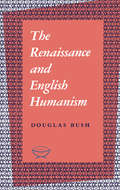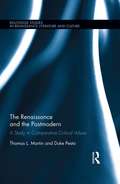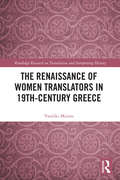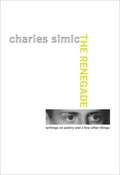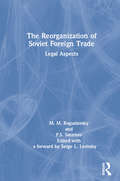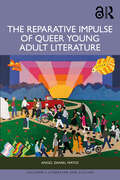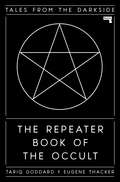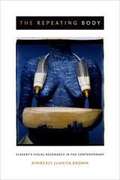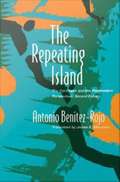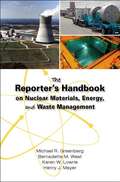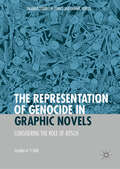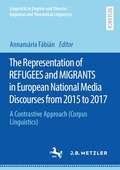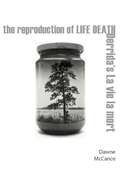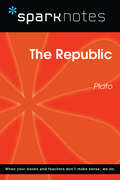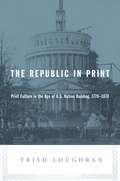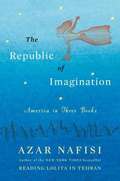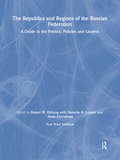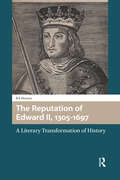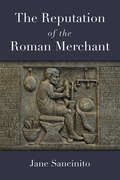- Table View
- List View
The Renaissance and English Humanism
by Douglas BushThe appearance of a fourth printing of The Renaissance and English Humanism indicated the scholarly success this book has enjoyed for more than a decade. As a brief yet thoughtful and eloquent evaluation of the influence of the Christian humanistic tradition upon our culture it has not been surpassed. The study is divided into four parts: in the first, Professor Bush discusses modern theories of the Renaissance; in the second and third, the character of classical humanism on the Continent and in England; and in the fourth, the place of Milton in the humanistic tradition."Douglas Bush has shown an unusual awareness," wrote Wallace K. Ferguson, "of the historiographical evolution of the Renaissance, and has taken his stand with rare explicitness on the side of those who find the Renaissance filled with mediaeval traditions." Professor Bush sees the dominant ideal of the English Renaissance as rational and religious order, rather than rebellious individualism, and his view has provided an important clue to the English literature and thought of the 16th and the earlier 17th century.
The Renaissance and the Postmodern: A Study in Comparative Critical Values (Routledge Studies in Renaissance Literature and Culture)
by Thomas L Martin Duke PestaThe Renaissance and the Postmodern reconsiders postmodern readings of Renaissance texts by engaging in a dialectics the authors call comparative critical values. Rather than concede the contemporary hierarchy of theory over literature, the book takes the novel approach of consulting major Renaissance writers about the values at work in postmodern representations of early modern culture. As criticism seeks new directions and takes new forms, insufficient attention has been paid to the literary and philosophical values won and lost in the exchanges. One result is that the way we understand the logical connections, the literary textures, and the philosophical impulses that make up the literature of writers like Spenser, Shakespeare, and Milton has fundamentally changed. Examining theoretical debates now in light of polemical controversies then, the book goes beyond earlier studies in that it systematically examines the effects of these newer critical approaches across their materialist, historicist, deconstructive, and psychoanalytic manifestations. Bringing gravity and focus to this question of critical continuities and discontinuities, each chapter counterposes one major Renaissance voice with a postmodern one to probe these issues and with them the value of the cultural past. As voices on both sides of the historical divide illuminate key differences between the Renaissance and the Postmodern, a critical model emerges from the book to re-engage this period’s humane literature in a contemporary context with intellectual rigor and a renewed sense of cultural enrichment.
The Renaissance of Women Translators in 19th-Century Greece (Routledge Research on Translation and Interpreting History)
by Vasiliki MisiouThis volume offers an in-depth exploration of the translation activity of Greek women translators in the nineteenth century, illuminating the role of translation as a means of resistance against sociocultural norms and the enduring impact of their work on the rise of feminism in Greece. Drawing on frameworks from the sociology of translation, the book situates the practices and behaviours of women translators within this specific sociocultural and historical context to underscore the importance of translation in their lives and society. Drawing on authentic texts, including dedication letters and prologues, Misiou unpacks the discourses, themes, strategies, and dialogues individual translators employed to affirm a sense of agency in their claims to education and civil rights, their role in cultural life as producers of texts, and to give greater voice to the wider community of women translators. The volume showcases women translators as agents and mediators of cultural and social change and active contributors to the theory and practice of translation, expanding theoretical discourse on gender and translation and offering directions for future research. This book will be of particular interest to scholars in translation studies, particularly those with an interest in translation and gender, feminist translation studies, and translation history.
The Renaissance: Activity Book (Amplify Core Knowledge Language Arts, Grade 5 #Unit 5)
by Amplify EducationNIMAC-sourced textbook
The Renaissance: Patrons, Artists and Scholars, Reader (Amplify Core Knowledge Language Arts,)
by Amplify Learning<P>Unit 5 The reader Patrons, Artists, and Scholars focuses on western Europe, particularly Italy, during the cultural movement known as the Renaissance. <P>"Students will be exposed to works of art from such renowned artists as Leonardo da Vinci, Michelangelo, Raphael, Donatello, Brunelleschi, Botticelli, Bruegel, Dürer, and Van Eyck, among others. Students will learn about the impact of Renaissance writers, such as Machiavelli, Castiglione, Cervantes, and Shakespeare.”(TG, Unit 5, p.2)
The Renaissance: Reader (Amplify Core Knowledge Language Arts, Grade 5 #Unit 5)
by Amplify EducationNIMAC-sourced textbook
The Renegade: Writings on Poetry and a Few Other Things
by Charles SimicSimic was born in Belgrade in 1938 and his childhood was marked by war. By 1954 he was in Chicago. By 1959 he was a published poet, and after a degree from New York U. he published the first of over 60 books. In time Simic (literature, U. of New Hampshire) the refugee was Simic the US Poet Laureate. His intuitive understanding of the bizarre has remained with him throughout, and this collection of writings reveals some of the reasons why this unique trait has helped to make him one of the great twentieth and twenty-first century poets. He explains attraction, reflection, rule-making, devotion, utopianism, marginalization and the heart of the poet along with the moments in his life that shaped his mind and spirit, and critiques the works of authors ranging from Christopher Marlow to Emily Dickenson, Edwin Arlington Robinson, Robert Creeley, and Zbigniew Herbert. Annotation ©2009 Book News, Inc., Portland, OR (booknews.com)
The Reorganization of Soviet Foreign Trade: Legal Aspects
by Serge L. Levitsky Mark M. Boguslavski P.S. Smirnov S.L. Levitsky M. M. Boguslavski D.M. McCauleyTranslated from the Russian. Edited and with a foreword by Serge L. Levitsky. A systematic and authoritative analysis of current Soviet legislation related to the organization and the mechanism of foreign economic relations under perestroika. Of particular interest to prospective partners in joint v
The Reparative Impulse of Queer Young Adult Literature (Children's Literature and Culture)
by Angel Daniel MatosThe Reparative Impulse of Queer Young Adult Literature is a provocative meditation on emotion, mood, history, and futurism in the critique of queer texts created for younger audiences. Given critical demands to distance queer youth culture from narratives of violence, sadness, and hurt that have haunted the queer imagination, this volume considers how post-2000s YA literature and media negotiate their hopeful purview with a broader—and ongoing—history of queer oppression and violence. It not only considers the tactics that authors use in bridging a supposedly “bad” queer past with a “better” queer present, but also offers strategies on how readers can approach YA reparatively given the field’s attachments to normative, capitalist, and neoliberal frameworks. Central to Matos’ argument are the use of historical hurt to spark healing and transformation, the implementation of disruptive imagery and narrative structures to challenge normative understandings of time and feeling, and the impact of intersectional thinking in reparative readings of queer youth texts. The Reparative Impulse of Queer Young Adult Literature shows how YA cultural productions are akin to the broader queer imagination in their ability to move and affect audiences, and how these texts encapsulate a significant and enduring change in terms of how queerness is—or can be—read, structured, represented, and felt. The Open Access version of this book, available at http://www.taylorfrancis.com, has been made available under a Creative Commons Attribution-Non Commercial-No Derivatives (CC-BY-NC-ND) 4.0 license.
The Repeater Book of the Occult
by Tariq Goddard And Eugene ThackerA selection of Repeater authors choose their favourite forgotten horror stories for this new anthology, with each also writing a critical introduction for the story of their choice.A selection of Repeater authors choose their favourite horror stories for this new anthology, with each writing a critical introduction for the story of their choice.Edited by novelist and Repeater publisher Tariq Goddard and "horror philosopher" Eugene Thacker, The Repeater Book of the Occult is a new anthology of horror stories that explores the ever-shifting boundaries between the natural and supernatural, between the real and the unreal. As the editors note, "In the grey zone between what appears and what is, lies horror. But horror writing is also a certain disposition, a way of thinking based on a suspicion regarding the world as it is given to us, and a doubt regarding the accepted ways of explaining that world to us - and for us."The Repeater Book of the Occult includes introductions by Repeater authors such as Leila Taylor, Carl Neville, Rhian E Jones, and Elvia Wilk, and features horror classics by Algernon Blackwood, Charlotte Perkins Gilman, and Edgar Allan Poe, as well as forgotten gems by authors such as W.W. Jacobs, Mark Twain, and Sheridan Le Fanu.
The Repeating Body: Slavery's Visual Resonance in the Contemporary
by Kimberly Juanita BrownHaunted by representations of black women that resist the reality of the body's vulnerability, Kimberly Juanita Brown traces slavery's afterlife in black women's literary and visual cultural productions. Brown draws on black feminist theory, visual culture studies, literary criticism, and critical race theory to explore contemporary visual and literary representations of black women's bodies that embrace and foreground the body's vulnerability and slavery's inherent violence. She shows how writers such as Gayl Jones, Toni Morrison, Audre Lorde, and Jamaica Kincaid, along with visual artists Carrie Mae Weems and María Magdalena Campos-Pons, highlight the scarred and broken bodies of black women by repeating, passing down, and making visible the residues of slavery's existence and cruelty. Their work not only provides a corrective to those who refuse to acknowledge that vulnerability, but empowers black women to create their own subjectivities. In The Repeating Body, Brown returns black women to the center of discourses of slavery, thereby providing the means with which to more fully understand slavery's history and its penetrating reach into modern American life.
The Repeating Island: The Caribbean and the Postmodern Perspective Second Edition
by Antonio Benítez-RojoIn this second edition of The Repeating Island, Antonio Bentez-Rojo, a master of the historical novel, short story, and critical essay, continues to confront the legacy and myths of colonialism. This co-winner of the 1993 MLA Katherine Singer Kovacs Prize has been expanded to include three entirely new chapters that add a Lacanian perspective and a view of the carnivalesque to an already brilliant interpretive study of Caribbean culture. As he did in the first edition, Bentez-Rojo redefines the Caribbean by drawing on history, economics, sociology, cultural anthropology, psychoanalysis, literary theory, and nonlinear mathematics. His point of departure is chaos theory, which holds that order and disorder are not the antithesis of each other in nature but function as mutually generative phenomena. Bentez-Rojo argues that within the apparent disorder of the Caribbean--the area's discontinuous landmasses, its different colonial histories, ethnic groups, languages, traditions, and politics--there emerges an "island" of paradoxes that repeats itself and gives shape to an unexpected and complex sociocultural archipelago. Bentez-Rojo illustrates this unique form of identity with powerful readings of texts by Las Casas, Guilln, Carpentier, Garca Mrquez, Walcott, Harris, Buitrago, and Rodrguez Juli.
The Reporter's Handbook on Nuclear Materials, Energy & Waste Management
by Michael R. Greenberg Bernadette M. West Karen W. Lowrie Henry J. MayerAn essential reference for journalists, activists, and students, this book presents scientifically accurate and accessible overviews of 24 of the most important issues in the nuclear realm, including: health effects, nuclear safety and engineering, TMI and Chernobyl, nuclear medicine, food irradiation, transport of nuclear materials, spent fuel, nuclear weapons, global warming. Each "brief" is based on interviews with named scientists, engineers, or administrators in a nuclear specialty, and each has been reviewed by a team of independent experts. The objective is not to make a case for or against nuclear-related technologies, but rather to provide definitive background information. (The approach is based on that of The Reporter's Environmental Handbook, published in 1988, which won a special award for journalism from the Sigma Delta Chi Society of professional journalists.)Other features of the book include: a glossary of hundreds of terms, an introduction to risk assessment, environmental and economic impacts, and public perceptions, an article by an experienced reporter with recommendations about how to cover nuclear issues, quick guides to the history of nuclear power in the United States, important federal legislation and regulations, nuclear position statements, and key organizations, print and electronic resources.
The Reporter's Handbook on Nuclear Materials, Energy, and Waste Management
by Michael R. Greenberg Bernadette M. West Karen W. Lowrie Henry J. MayerAn essential reference for journalists, activists, and students, this book presents scientifically accurate and accessible overviews of 24 of the most important issues in the nuclear realm, including: health effects, nuclear safety and engineering, TMI and Chernobyl, nuclear medicine, food irradiation, transport of nuclear materials, spent fuel, nuclear weapons, global warming.Each "brief" is based on interviews with named scientists, engineers, or administrators in a nuclear specialty, and each has been reviewed by a team of independent experts. The objective is not to make a case for or against nuclear-related technologies, but rather to provide definitive background information. (The approach is based on that of The Reporter's Environmental Handbook, published in 1988, which won a special award for journalism from the Sigma Delta Chi Society of professional journalists.)Other features of the book include: a glossary of hundreds of terms, an introduction to risk assessment, environmental and economic impacts, and public perceptions, an article by an experienced reporter with recommendations about how to cover nuclear issues, quick guides to the history of nuclear power in the United States, important federal legislation and regulations, nuclear position statements, and key organizations, print and electronic resources.
The Representation of Genocide in Graphic Novels: Considering The Role Of Kitsch (Palgrave Studies In Comics And Graphic Novels Ser.)
by Laurike in 't VeldThis book mobilises the concept of kitsch to investigate the tensions around the representation of genocide in international graphic novels that focus on the Holocaust and the genocides in Armenia, Rwanda, and Bosnia. In response to the predominantly negative readings of kitsch as meaningless or inappropriate, this book offers a fresh approach that considers how some of the kitsch strategies employed in these works facilitate an affective interaction with the genocide narrative. These productive strategies include the use of the visual metaphors of the animal and the doll figure and the explicit and excessive depictions of mass violence. The book also analyses where kitsch still produces problems as it critically examines depictions of perpetrators and the visual and verbal representations of sexual violence. Furthermore, it explores how graphic novels employ anti-kitsch strategies to avoid the dangers of excess in dealing with genocide. The Representation of Genocide in Graphic Novels will appeal to those working in comics-graphic novel studies, popular culture studies, and Holocaust and genocide studies.
The Representation of REFUGEES and MIGRANTS in European National Media Discourses from 2015 to 2017: A Contrastive Approach (Corpus Linguistics) (Linguistik in Empirie und Theorie/Empirical and Theoretical Linguistics)
by Annamária FábiánThough the refugee crisis was discussed in many countries e.g. in Greece, Hungary, Italy and Spain long before 2015, it began to receive cross- European press coverage only after Angela Merkel’s statement ‘Wir schaffen das!’ on the August 30th 2015 This data-based study focuses on, how journalists report on and leading politicians make statements about refugees, migrants and asylum seekers in media and frame these humans after Angela Merkels’ sentence in 2015 until the end of 2017. This volume uses mainly Corpus Linguistics but also Communicative Science for the analysis of labelling strategies and the usage of words, collocations and grammar systems used by journalists and politicians in different European countries in comparison. This empirical volume pictures language specific variation and change of labels. To enable a contrastive study between the press discourses of many European countries, every chapter analyses the data consisting of newspaper articles describing the discourse of a particular country, including discourses of some transit countries around the borders of the Schengen Area of the European Union, which barely have been covered in other studies.
The Representation of War in German Literature
by Elisabeth KrimmerThe history of literature about war is marked by a fundamental paradox: although war forms the subject of countless novels, dramas, poems, and films, it is often conceived as indescribable. Even as many writers strive towards an ideal of authenticity, they maintain that no representation can do justice to the terror and violence of war. Readings of Schiller, Kleist, J8nger, Remarque, Grass, B_ll, Handke, and Jelinek reveal that stylistic and aesthetic features, gender discourses, and concepts of agency and victimization can all undermine a text's martial stance or its ostensible pacifist agenda. Spanning the period from the Revolutionary and Napoleonic Wars to the recent wars in Yugoslavia and Iraq, Elisabeth Krimmer investigates the aesthetic, theoretical, and historical challenges that confront writers of war.
The Reproduction of Life Death: Derrida's La vie la mort
by Dawne McCanceDuring the 1975–76 academic year, Jacques Derrida delivered a seminar, La vie la mort (Life Death), at the École normale supérieure, in Paris. Based on archival translations of this untapped but soon-to-be-published seminar, The Reproduction of Life Death offers an unprecedented study of Derrida’s engagement with molecular biology and genetics, particularly the work of the biologist François Jacob.Structured as an itinerary of “three rings,” each departing from and coming back to Nietzsche, Derrida’s seminar ties Jacob’s logocentric account of reproduction to the reproductive program of teaching that characterizes the academic institution, challenging this mode of teaching as auto-reproduction along with the concept of “academic freedom” on which it is based. McCance also brings Derrida’s critique of Jacob’s theory of auto-reproduction together with his reading of reproductivity, the tendency to repeat-reproduce, that is theorized and enacted in Freud’s Beyond the Pleasure Principle. The book further shows how Derrida’s account of life death relates to his writings on autobiography and the signature and to such later concerns as the question of the animal.McCance brings extensive archival research together with a deep knowledge of Derrida’s work a background in genetics to offer a fascinating new account of an encounter between philosophy and the hard sciences that will be of interest to theorists in a wide range of disciplines concerned with the question of life.
The Republic (SparkNotes Philosophy Guide)
by SparkNotesThe Republic (SparkNotes Philosophy Guide) Making the reading experience fun! SparkNotes Philosophy Guides are one-stop guides to the great works of philosophy–masterpieces that stand at the foundations of Western thought. Inside each Philosophy Guide you&’ll find insightful overviews of great philosophical works of the Western world.
The Republic in Print: Print Culture in the Age of U.S. Nation Building, 1770-1870
by Trish Loughran"In the beginning, all the world was America."-John LockeIn the beginning, everything was America, but where did America begin? In many narratives of American nationalism (both popular and academic), the United States begins in print-with the production, dissemination, and consumption of major printed texts like Common Sense , the Declaration of Independence, newspaper debates over ratification, and the Constitution itself. In these narratives, print plays a central role in the emergence of American nationalism, as Americans become Americans through acts of reading that connect them to other like-minded nationals.In The Republic in Print, however, Trish Loughran overturns this master narrative of American origins and offers a radically new history of the early republic and its antebellum aftermath. Combining a materialist history of American nation building with an intellectual history of American federalism, Loughran challenges the idea that print culture created a sense of national connection among different parts of the early American union and instead reveals the early republic as a series of local and regional reading publics with distinct political and geographical identities.Focusing on the years between 1770 and 1870, Loughran develops two richly detailed and provocative arguments. First, she suggests that it was the relative lack of a national infrastructure (rather than the existence of a tightly connected print network) that actually enabled the nation to be imagined in 1776 and ratification to be secured in 1787-88. She then describes how the increasingly connected book market of the 1830s, 1840s, and 1850s unexpectedly exposed cracks in the evolving nation, especially in regards to slavery, exacerbating regional differences in ways that ultimately contributed to secession and civil war.Drawing on a range of literary, historical, and archival materials-from essays, pamphlets, novels, and plays, to engravings, paintings, statues, laws, and maps- The Republic in Print provides a refreshingly original cultural history of the American nation-state over the course of its first century.
The Republic of Imagination
by Azar NafisiA passionate hymn to the power of fiction to change people's lives, by the #1 New York Times bestselling author of Reading Lolita in Tehran Ten years ago, Azar Nafisi electrified readers with her million-copy bestseller, Reading Lolita in Tehran, which told the story of how, against the backdrop of morality squads and executions, she taught The Great Gatsby and other classics to her eager students in Iran. In this exhilarating followup, Nafisi has written the book her fans have been waiting for: an impassioned, beguiling, and utterly original tribute to the vital importance of fiction in a democratic society. What Reading Lolita in Tehran was for Iran, The Republic of Imagination is for America. Taking her cue from a challenge thrown to her in Seattle, where a skeptical reader told her that Americans don't care about books the way they did back in Iran, she energetically responds to those who say fiction has nothing to teach us. Blending memoir and polemic with close readings of her favorite American novels--The Adventures of Huckleberry Finn, Babbitt, and The Heart Is a Lonely Hunter, among others--she invites us to join her as citizens of her "Republic of Imagination," a country where the villains are conformity and orthodoxy and the only passport to entry is a free mind and a willingness to dream.
The Republic of Imagination
by Azar NafisiThe author of the beloved #1 New York Times bestseller Reading Lolita in Tehran returns with the next chapter of her life in books--a passionate and deeply moving hymn to America Ten years ago, Azar Nafisi electrified readers with her multimillion-copy bestseller Reading Lolita in Tehran, which told the story of how, against the backdrop of morality squads and executions, she taught The Great Gatsby and other classics of English and American literature to her eager students in Iran. In this electrifying follow-up, she argues that fiction is just as threatened--and just as invaluable--in America today.Blending memoir and polemic with close readings of her favorite novels, she describes the unexpected journey that led her to become an American citizen after first dreaming of America as a young girl in Tehran and coming to know the country through its fiction. She urges us to rediscover the America of The Wonderful Wizard of Oz and Adventures of Huckleberry Finn and challenges us to be truer to the words and spirit of the Founding Fathers, who understood that their democratic experiment would never thrive or survive unless they could foster a democratic imagination. Nafisi invites committed readers everywhere to join her as citizens of what she calls the Republic of Imagination, a country with no borders and few restrictions, where the only passport to entry is a free mind and a willingness to dream.From the Trade Paperback edition.
The Republics and Regions of the Russian Federation: A Guide to the Politics, Policies and Leaders
by Robert W. Orttung East West InsituteRussia is divided into seven federal districts encompassing 89 units -- regions (oblasts), territories (krais), and republics. As central power has weakened, the importance of these units and their local leadership has increased commensurately.This work brings together in one volume all basic political, economic, and demographic data on every territorial unit of the Russian Federation, its local government structure, and electoral history current through the spring 2000 elections and the summer 2000 reorganization. Each entry includes an extensive profile of the president, governor, or prime minister, and an overview of local political trends, policies, economy, and business conditions.
The Reputation of Edward II, 1305-1697: A Literary Transformation of History (Gendering the Late Medieval and Early Modern World)
by Kit HeyamDuring his lifetime and the four centuries following his death, King Edward II (1307-1327) acquired a reputation for having engaged in sexual and romantic relationships with his male favourites, and having been murdered by penetration with a red-hot spit. This book provides the first account of how this reputation developed, providing new insights into the processes and priorities that shaped narratives of sexual transgression in medieval and early modern England. In doing so, it analyses the changing vocabulary of sexual transgression in English, Latin and French; the conditions that created space for sympathetic depictions of same-sex love; and the use of medieval history in early modern political polemic. It also focuses, in particular, on the cultural impact of Christopher Marlowe's Edward II (c.1591-92). Through such close readings of poetry and drama, alongside chronicle accounts and political pamphlets, it demonstrates that Edward's medieval and early modern afterlife was significantly shaped by the influence of literary texts and techniques. A 'literary transformation' of historiographical methodology is, it argues, an apposite response to the factors that shaped medieval and early modern narratives of the past.
The Reputation of the Roman Merchant (Law And Society In The Ancient World)
by Jane SancinitoRoman merchants, artisans, and service providers faced substantial prejudice. Contemporary authors labeled them greedy, while the Roman on the street accused merchants of lying and cheating. Legally and socially, merchants were kept at arm’s length from respectable society. Yet merchants were common figures in daily life, populating densely packed cities and traveling around the Mediterranean. The Reputation of the Roman Merchant focuses on the strategies retailers, craftsmen, and many other workers used to succeed, examining how they developed good reputations despite the stigma associated with their work. In a novel approach, blending social and economic history, The Reputation of the Roman Merchant considers how reputation worked as an informal institution, establishing and reinforcing traditional Roman norms while lowering the cost of doing business for individual workers. From histories and novels to inscriptions and art, this volume identifies common reputation strategies, explores how points of pride and personal accomplishments were shared with others, and explains responses to merchant activities on the small-scale. The book concludes that merchants invested heavily in their reputations as a way to set themselves apart from common, negative stereotypes without admitting that there was anything shameful about the work they did.
